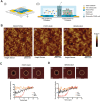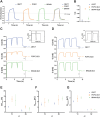Concealing Organic Neuromorphic Devices with Neuronal-Inspired Supported Lipid Bilayers
- PMID: 38702931
- PMCID: PMC11251551
- DOI: 10.1002/advs.202305860
Concealing Organic Neuromorphic Devices with Neuronal-Inspired Supported Lipid Bilayers
Abstract
Neurohybrid systems have gained large attention for their potential as in vitro and in vivo platform to interrogate and modulate the activity of cells and tissue within nervous system. In this scenario organic neuromorphic devices have been engineered as bioelectronic platforms to resemble characteristic neuronal functions. However, aiming to a functional communication with neuronal cells, material synthesis, and surface engineering can yet be exploited for optimizing bio-recognition processes at the neuromorphic-neuronal hybrid interface. In this work, artificial neuronal-inspired lipid bilayers have been assembled on an electrochemical neuromorphic organic device (ENODe) to resemble post-synaptic structural and functional features of living synapses. Here, synaptic conditioning has been achieved by introducing two neurotransmitter-mediated biochemical signals, to induce an irreversible change in the device conductance thus achieving Pavlovian associative learning. This new class of in vitro devices can be further exploited for assembling hybrid neuronal networks and potentially for in vivo integration within living neuronal tissues.
Keywords: neurohybrids; neuromorphic devices; organic electrochemical transistor; supported lipid bilayer.
© 2024 The Authors. Advanced Science published by Wiley‐VCH GmbH.
Conflict of interest statement
The authors declare no conflict of interest.
Figures




Similar articles
-
Enzyme-Mediated Organic Neurohybrid Synapses.Adv Mater. 2024 Dec;36(49):e2409614. doi: 10.1002/adma.202409614. Epub 2024 Oct 14. Adv Mater. 2024. PMID: 39402777 Free PMC article.
-
Supported Lipid Bilayers Coupled to Organic Neuromorphic Devices Modulate Short-Term Plasticity in Biomimetic Synapses.Adv Mater. 2022 Apr;34(15):e2110194. doi: 10.1002/adma.202110194. Epub 2022 Mar 4. Adv Mater. 2022. PMID: 35174916
-
Organic Synapses for Neuromorphic Electronics: From Brain-Inspired Computing to Sensorimotor Nervetronics.Acc Chem Res. 2019 Apr 16;52(4):964-974. doi: 10.1021/acs.accounts.8b00553. Epub 2019 Mar 21. Acc Chem Res. 2019. PMID: 30896916 Review.
-
Compact Artificial Synapse-Neuron Module with Chemically Mediated Spiking Behaviors.ACS Nano. 2025 Apr 1;19(12):12298-12307. doi: 10.1021/acsnano.5c01406. Epub 2025 Mar 20. ACS Nano. 2025. PMID: 40114422
-
Two-dimensional materials for synaptic electronics and neuromorphic systems.Sci Bull (Beijing). 2019 Aug 15;64(15):1056-1066. doi: 10.1016/j.scib.2019.01.016. Epub 2019 Jan 31. Sci Bull (Beijing). 2019. PMID: 36659765 Review.
Cited by
-
Enzyme-Mediated Organic Neurohybrid Synapses.Adv Mater. 2024 Dec;36(49):e2409614. doi: 10.1002/adma.202409614. Epub 2024 Oct 14. Adv Mater. 2024. PMID: 39402777 Free PMC article.
-
Bioinspired Electrolyte-Gated Organic Synaptic Transistors: From Fundamental Requirements to Applications.Nanomicro Lett. 2025 Mar 24;17(1):198. doi: 10.1007/s40820-025-01708-1. Nanomicro Lett. 2025. PMID: 40122950 Free PMC article. Review.
-
Lateral nanoarchitectonics from nano to life: ongoing challenges in interfacial chemical science.Chem Sci. 2024 Oct 28;15(45):18715-18750. doi: 10.1039/d4sc05575f. eCollection 2024 Nov 20. Chem Sci. 2024. PMID: 39568623 Free PMC article. Review.
References
-
- Christensen D. V., Dittmann R., Linares‐Barranco B., Sebastian A., Gallo M. L., Redaelli A., Slesazeck S., Mikolajick T., Spiga S., Menzel S., Valov I., Milano G., Ricciardi C., Liang S.‐J., Miao F., Lanza M., Quill T. J., Keene S. T., Salleo A., Grollier J., Marković D., Mizrahi A., Yao P., Yang J. J., Indiveri G., Strachan J. P., Datta S., Vianello E., Valentian A., Feldmann J., et al., Neuromorph. Comput. Eng. 2022, 2, 022501.
-
- Mariano A., Bovio C. L., Criscuolo V., Santoro F., Nanotechnology 2022, 33, 492501. - PubMed
-
- Hao W., Han J., Chu Y., Huang L., Sun J., Zhuang Y., Li X., Ma H., Chen Y., Dai J., Biomaterials 2018, 161, 106. - PubMed
MeSH terms
Substances
Grants and funding
LinkOut - more resources
Full Text Sources
